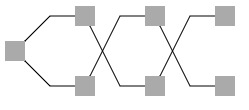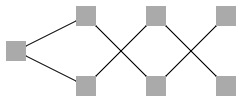dagrejs - Layered layout for directed acyclic graph
This project is a fork from dagre. For more information prelase refer to origin project.
Enhanced features
New features:
- support specify layer(rank) for certain node
- support manually control nodes' order
- support keep origin layout when re-layout with nodes added
Optimizations:
- rewrite rank algorithm to support assign layer
- consider previous iteration result at node-ordering step
- support generate
edgeLabelSpacingor not, which controls generate dummy node between nodes
Usage
For full usage please refer to dagre's documentation: https://github.com/dagrejs/dagre/wiki.
edgeLabelSpace
Default dagre always generate dummy node for every edge, which can be used for edge's curve drawing, etc. If you do not need it, disable it in layout's options:
dagre.layout(g, {
edgeLabelSpace: false
})Bellow shows graph with or without edgeLabelSpace:
Specify layer
Now you can manually specify node's layer(rank) by add layer in node's attribute:
const data = {
nodes: [
{ id: '0' },
{ id: '1', layer: 1 },
{ id: '2', layer: 3 },
{ id: '3' },
],
// edges: [...]
}
data.nodes.forEach((n) => {
g.setNode(n.id, n);
});Caution:
- layer is 0-indexed, which means the root node's layer is 0
- manual layer should not violate DAG's properties (e.g. You cannot assign a layer value for a target node greater or equal to cresponding source node.)
Control nodes' order
Sometimes we want to manually control nodes' order in every layer in case of unexpected result caused by alogrithm. Now we can also configurate in options.
dagre.layout(g, {
keepNodeOrder: true,
nodeOrder: ['3', '2', '1', '0'] // an array of nodes's ID.
});A common usage is keeping data's order:
const data = {
nodes: [
{ id: '0' },
{ id: '2' },
{ id: '3' },
{ id: '1' },
],
// edges: [...]
}
dagre.layout(g, {
keepNodeOrder: true,
nodeOrder: data.nodes.map(n => n.id)
});Caution:
- The order only work at same layer ordering step. It does not affect the layer assignment step.
- Like specifying layer, internally the library added
fixorderattribute for each node. Of cause you can manually set this attribute, but it introduces ambiguity.
Keep origin layout
When re-layout with small modification, we may want to keep origin layout result. Now we can pass the origin graph to new layout function:
dagre.layout(originGraph) // layout() will internally modify originGraph
dagre.layout(
g,
{
prevGraph: originGraph // pass originGraph to new function
}
);For full example please refer to add-subgraph example in examples folder.

